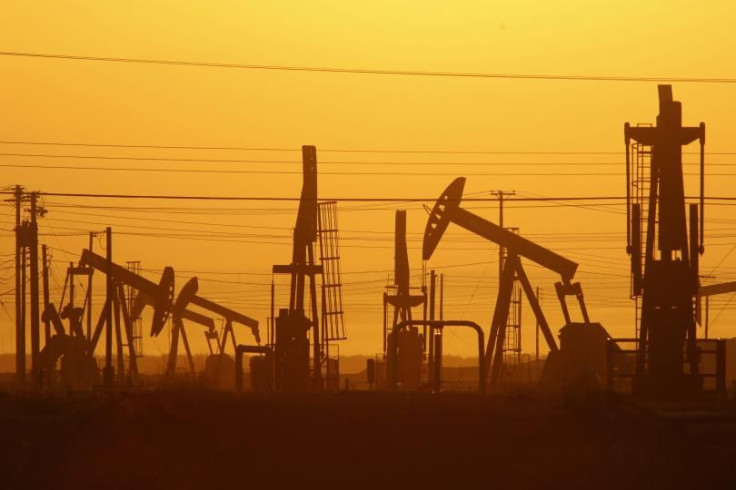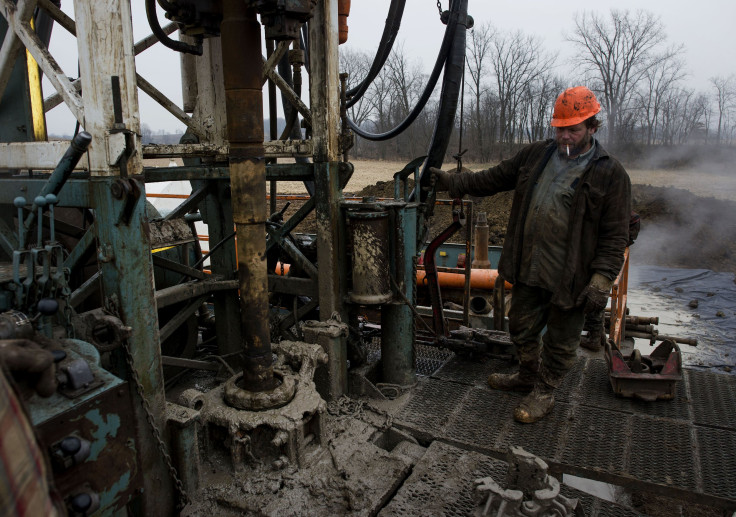Can California Ban Fracking?

This story is being co-published with Capital & Main as part of a series on California Game Changers: Nine Big Ideas That Could Transform the State and Nation.
If you were to parachute into Kern County about 40 miles west of Bakersfield, you might doubt California’s status as a national leader on climate. Pumpjacks spread out in every direction across a hellscape scraped bare of anything green. Scattered at irregular intervals, spires of latticed steel reach up more than a hundred feet, secured with guywires: evidence of hydraulic fracturing, a practice sufficiently infamous that its household nickname, fracking, invokes images of tap water so toxic you can light it on fire.
Fracked oil wells are everywhere on this southeastern extreme of the San Joaquin Valley, hard by the leeward side of the San Andreas fault. Big oil companies such as Chevron and Mobil began hydraulically fracturing wells here in earnest during the late 1970s, after the OPEC embargo made oil expensive and scarce. Drillers learned that by injecting a powerful slurry of chemical-laden water and sand into sedimentary rock, they could blast under played-out conventional wells and squeeze out oil left trapped in fissures, or could access reserves that traditional drilling otherwise couldn’t. (They could also inject acid into a certain kind of petroleum-bearing rock to dissolve it, another “well stimulation” method less common, but just as controversial, as hydraulic fracturing.)
Environmentalists and community activists have long lobbied for a statewide ban on fracking, arguing that the unique chemical cocktails that make up fracking fluids present novel risks to human health. “Given what we know about fracking’s dangers, [banning it] is just a no-brainer,” says Hollin Kretzmann, a staff attorney with the Center for Biological Diversity. But up until two year ago, no one but the drillers even knew where fracking was happening.
“We didn’t know how much water was being used, which chemicals they were using, even where it was happening — it was a big data vacuum,” says Briana Mordick, senior scientist with the Natural Resources Defense Council. That changed with the 2013 passage of Senate Bill 4, then-State Senator Fran Pavley’s well stimulation disclosure act. Now, you can look up fracked wells on a map maintained by the California Division of Oil, Gas and Geothermal Resources.
You can also look up what each company puts in its fracking fluids, which may or may not be meaningful. “Two-thirds of the chemicals used in fracking don’t have any public health profiles,” Mordick says. No one has yet done the studies to prove what dangers the chemicals pose. We might know that a common component of acidizing, hydrofluoric acid, eats away at your bones (one drop on your finger and you cut it off or die). But we don’t know whether any chemical escaped into the environment and directly made anyone sick.
Other industries have more established connections to Kern County’s elevated rates of lung disorders and heart disease. Poverty takes a toll on health, as do pesticides from farm fields and exhaust from two major freeways and a railroad. “We are the heart of California,” says Juan Flores, a 31-year-old community organizer with the Center on Race, Poverty & the Environment, in Delano, a mostly agricultural city about half an hour north of Bakersfield. “If something gets moved from north to south in this state, it goes through here.”
Flores figures that each of the county’s principal industries — oil, agriculture and goods movement — account for about a third of the valley’s pollution. Fracking is responsible for only about a fifth of oil’s contribution. Still, he believes a fracking ban is worth fighting for, if only because fracturing encourages wells to be drilled where there were none before. And even if fracking’s precise environmental damage remains somewhat of a mystery in California, the destruction wrought by oil and gas operations does not.
A recent study in rural Colorado found that children diagnosed with acute lymphoblastic leukemia were three to four times more likely to live in close proximity to an oil or gas site. Oil drilling in Los Angeles, which happens in dense, urban neighborhoods, has been associated with asthma, heart disease and low-birthweight babies, primarily because it exacerbates air pollution. Close to 300,000 people in Kern County reside within a mile of an oil well, the majority of them Latino and living near or below the federal poverty line. Hydraulic fracturing makes more oil possible.
Flores is a tall, imposing presence. He grew up in Mexicali and came to the U.S. as a teenager with his parents, both of whom are farmworkers. Despite spending four years as an anti-fracking activist, he seems relentlessly cheerful, even when discussing painful subjects. I ask whether he believes what oil company representatives have told me, all speaking on background: That the oil industry in California is subject to the strictest environmental rules in the nation. “The good part is that I do believe that,” he says. “The bad part is, if we’re dying in California, with the best of the best — I can only imagine the suffering they’re going through in Kansas, in North Dakota, in Texas. To kill the environment where people live,” he says, “that is the worst thing you can do.”
Fracking activity in the San Joaquin Valley slowed temporarily after SB 4’s rules took effect in 2015, says Kyle Ferrar, who monitors the Western U.S. for the FracTracker Alliance, a nonprofit that collects data and other information on fracking in the U.S. Besides disclosure, the law requires strict groundwater monitoring unless drillers obtain exemptions. “When those rules were passed, they were pretty strict, and rightfully so,” Ferrar says. Now permitting has picked up again, and thousands more wells have been stimulated since 2016.
Flores worries the upward trend could continue, especially as older fields age and if oil prices rise. When we spoke, the Bureau of Land Management had signaled an intent to open up more of California’s public lands to oil and gas exploration. A few weeks later, a federal judge struck down that plan, on the grounds that the agency failed to fully investigate the dangers of hydraulic fracturing, which could affect as many as a quarter of the new wells.

The administration still has options to pursue; the BLM could well come back with a revised plan sometime in the next four years and prevail. Flores hopes that before that happens, the California legislature will impose a statewide ban, despite the extent to which oil irrigates California politics. (Oil and gas interests donated $2.8 million to campaigns in the November 8, 2016 election. Close to 48 percent of those contributions went to Democrats.) In the meantime, he says, “we’re expecting and hoping is that [local lawmakers] will upgrade their county and city oil and gas ordinances, focusing on the health of the community,” he says. “[Then] the oil industry would not be so attracted to [these] communities to extract oil.”
Last year Monterey County voters did just that, bucking oil’s well-funded opposition to approve Measure Z, prohibiting fracking and other well-stimulation methods within the county’s boundaries. And unlike some other California counties that have passed similar laws — Santa Cruz, San Benito, Alameda, Butte and Mendocino — Monterey County actually has oil: More than 1,000 wells operate on four fields near San Ardo, in the Salinas Valley. Chevron and Aera Energy almost immediately filed suits to stop the law from being implemented, and public hearings over exemptions and timelines have been contentious.
Lawsuit or not, Hollin Kretzmann contends that Measure Z is a model for other jurisdictions that want to take action at a local level. “New York’s fracking ban started with a couple of rural townships,” he points out. “It spread to a dozen townships. The governor was under enormous pressure from the public, and facing the science was forced to [sign] a statewide ban.”
“The oil companies, they’re going to be left behind,” Juan Flores says, standing in the shade of an abundant valley oak in Panorama Park, an expanse of manicured grass on Bakersfield’s bluffs. The view from the bluffs is both breathtaking and dissonant: Looking down, you can see the lush green of the Kern River Valley; along the horizon a field of black pumpjacks, planted over scoured and parched brown earth, extend into apparent infinity. Flores traces with his finger the route of a canal that carries water left over from Chevron’s Kern River operations. Eventually, that water mixes with fresh water in an irrigation canal. During the drought of the last six years, farmers used it to keep their nut groves green. “Think about that,” Flores says, “when you eat your almonds and pistachios.”
It’s clear that Bakersfield’s boosters still take pride in this landscape. You don’t name bluffs, a park and a scenic drive “Panorama” because you’re ashamed of the view. But Flores notes that some of the field’s pumps have gone idle. Since oil-prices crashed from their well-over $100-a-barrel highs to under $50 a barrel in 2015, Kern County’s economy has struggled.
“I notice the anger, the frustration of the oil workers who have lost jobs,” he says. “I know it makes it worse for them seeing me in documentaries saying ‘Yeah, I really want fracking to stop.’ But what I want them to notice is that oil is not everything. They can jump on this train of renewable energy and be the leaders of it.”
He imagines another future for Bakersfield’s windy, sun-baked vista: Hundreds and thousands of solar panels and wind turbines, generating clean power for California’s grid. “Even more than that, I can see community members owning that energy, being part of it,” he says. “We’ll be so much better off with energy that won’t hurt us.”
Copyright Capital & Main
© Copyright IBTimes 2024. All rights reserved.





















